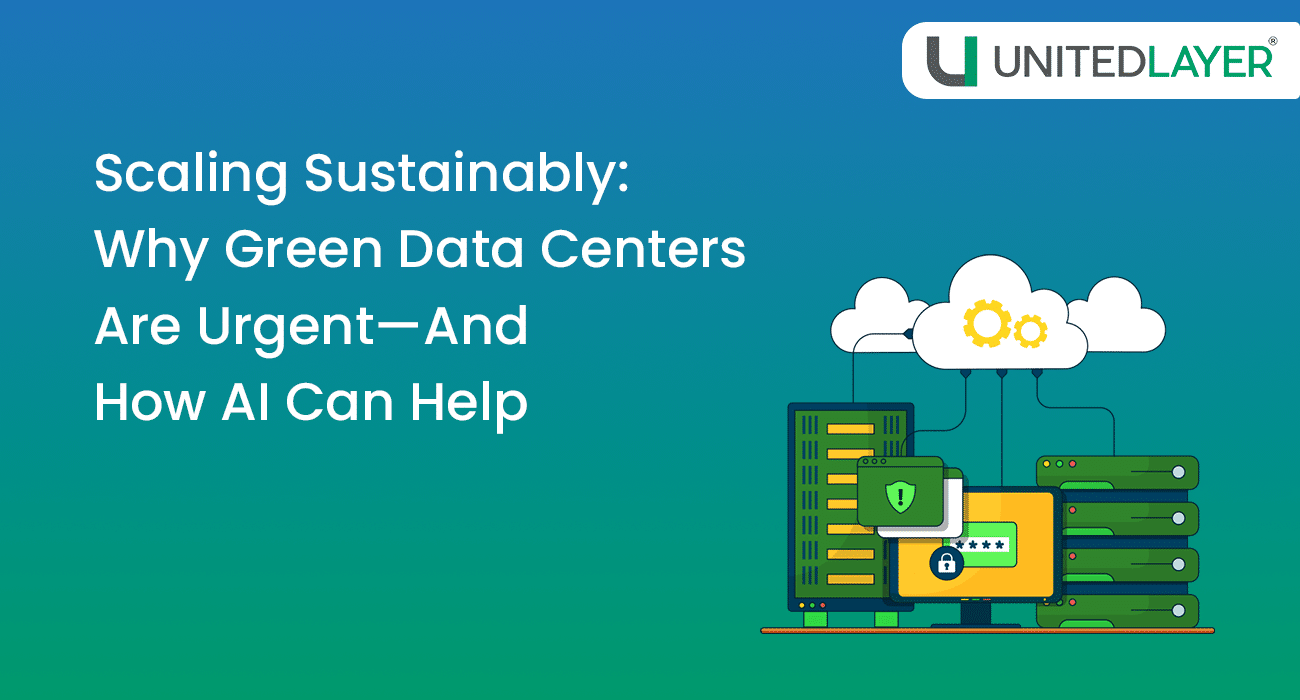
The surge in cloud adoption, AI workloads, and digital services has accelerated the global expansion of data centers. But this expansion comes at a steep environmental cost. Many facilities continue to scale without integrating sustainable practices, some even engaging in superficial greenwashing, resulting in increased energy consumption and emissions.
UnitedLayer brings forth a more responsible path for data center sustainability. Our strategy integrates advanced cooling techniques, renewable energy sourcing, and intelligent airflow engineering to power enterprise workloads responsibly and efficiently. With built-in GreenOps, UnitedLayer takes this commitment further, leveraging AI to monitor, optimize, and reduce the carbon footprint continuously.
Did you know data center facilities account for 1–3% of global electricity consumption, with projections indicating a rise to 10% by 2030, enough to power tens of millions of households. What’s more concerning is that the majority of this electricity still comes from fossil fuels. If current trends continue, the escalating power demand could lead to more than 100% increase in carbon dioxide emissions by 2030 compared to 2022, reaching an estimated 215–220 million metric tons annually.
A large share of this environmental footprint stems from inefficient cooling systems. Traditional methods, such as CRAC (Computer Room Air Conditioning) and CRAH (Computer Room Air Handling) units, are highly energy-intensive, often consuming more electricity than the IT equipment they are meant to cool down. This not only inflates operational costs but also worsens Power Usage Effectiveness (PUE) metrics. Additionally, many facilities rely on evaporative cooling systems that consume millions of gallons of water annually, placing further strain on natural resources.
The overprovisioning of compute capacity compounds the problem. To ensure high uptime and failover capacity, many data centers provision more servers and infrastructure than they use at any given time. However, these underutilized servers still consume power, generate heat, and require cooling, despite doing very little actual work. As a result, a lot of energy gets wasted, driving up emissions and costs without directly contributing to productivity or performance.
Global sentiment is shifting. Countries like India, Brazil, and Australia, already grappling with intensifying climate impacts, are ramping up IT investments focused on sustainability. But investment alone isn’t enough. Real progress demands urgent action that transcends conventional data center design.
Modern green data centers are adopting liquid cooling technologies such as direct-to-chip and immersion cooling, which circulate fluid directly over high-performance components. These systems provide superior thermal conductivity compared to air, significantly reducing energy use while offering greater temperature precision, particularly in high-density environments.
To further reduce cooling overhead and emissions, more facilities are transitioning to renewable energy sources like solar, hydro, and wind. This pivot away from fossil-fuel-based power not only supports operational efficiency but also helps meet long-term GHG reduction and sustainability goals.
Complementing these efforts are advanced airflow optimization practices. Techniques like intelligent server layout design help minimize hotspots and improve air circulation. At the same time, hot aisle/cold aisle containment prevents the mixing of hot and cold air streams, enhancing cooling efficiency and reducing strain on HVAC systems. Additionally, the deployment of rear-door heat exchangers and in-row cooling units enables localized, targeted thermal management. These solutions reduce energy waste and support higher compute density, without driving up overall power consumption.
After analyzing and adopting sustainable data center practices from across the globe, UnitedLayer delivers a best-in-class sustainability model, powered by intelligent automation. Our infrastructure strategy seamlessly combines advanced cooling, renewable energy sourcing, and airflow optimization to run enterprise workloads both efficiently and responsibly.
But the transformation does not stop at infrastructure. With the introduction of UnityOne.AI, UnitedLayer elevates sustainability, enabling real-time monitoring, dynamic optimization, and continuous reduction of the data center carbon footprint.
While 9 out of 10 executives believe AI can positively impact their sustainability goals, more than half still aren’t using it to drive those initiatives forward.
UnityOne.AI bridges the gap with AI-powered DCIM (Data Center Infrastructure Management), delivering real-time, centralized visibility into power distribution, cooling systems, and IT asset performance. Through continuous infrastructure monitoring, the platform detects energy inefficiencies, anticipates equipment stress, and recommends intelligent, automated adjustments. The result: seamless, data-driven optimization that accelerates your journey to net-zero, without compromising uptime or performance.
Balancing digital transformation with environmental responsibility is no longer optional. Sustainable data center design and operations are mission-critical for climate accountability. AI is no longer a “nice-to-have”—it is the intelligence layer required to drive measurable progress toward net-zero, from predictive energy optimization to carbon footprint tracking.
With UnitedLayer’s green data center infrastructure and UnityOne.AI’s built-in intelligence, enterprises are empowered to lead with responsibility, scaling seamlessly while minimizing environmental impact. Real-world deployments have already demonstrated significant reductions in energy usage and carbon emissions.
Ready to accelerate your path to net zero? Let’s build a more sustainable future together.